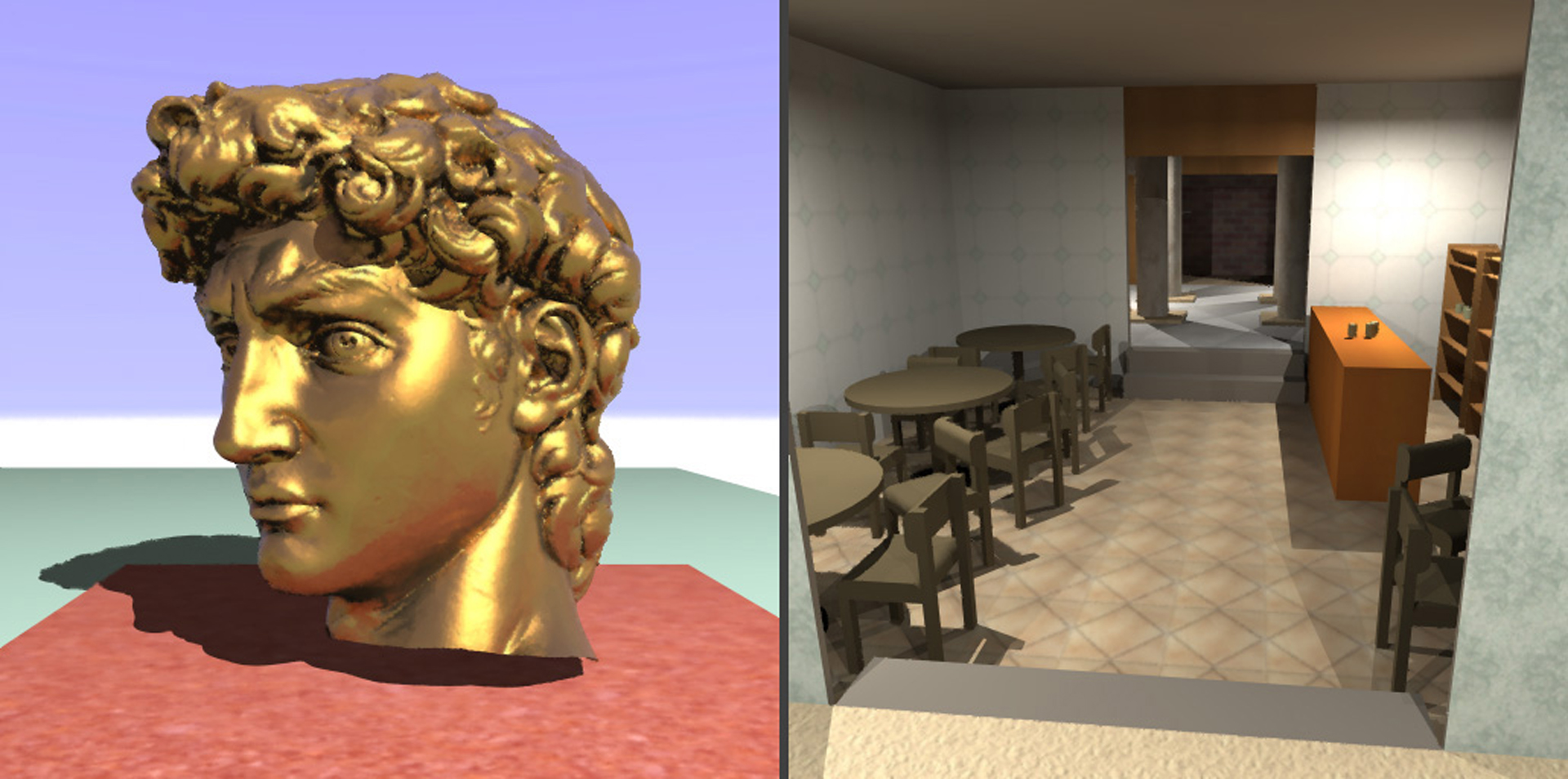“Combining edges and points for interactive high-quality rendering” by Bala, Walter and Greenberg
Conference:
Type(s):
Title:
- Combining edges and points for interactive high-quality rendering
Presenter(s)/Author(s):
Abstract:
This paper presents a new interactive rendering and display technique for complex scenes with expensive shading, such as global illumination. Our approach combines sparsely sampled shading (points) and analytically computed discontinuities (edges) to interactively generate high-quality images. The edge-and-point image is a new compact representation that combines edges and points such that fast, table-driven interpolation of pixel shading from nearby point samples is possible, while respecting discontinuities.The edge-and-point renderer is extensible, permitting the use of arbitrary shaders to collect shading samples. Shading discontinuities, such as silhouettes and shadow edges, are found at interactive rates. Our software implementation supports interactive navigation and object manipulation in scenes that include expensive lighting effects (such as global illumination) and geometrically complex objects. For interactive rendering we show that high-quality images of these scenes can be rendered at 8–14 frames per second on a desktop PC: a speedup of 20–60 over a ray tracer computing a single sample per pixel.
References:
1. BALA, K., DORSEY, J., AND TELLER, S. 1999. Interactive ray-traced scene editing using ray segment trees. In 10th Eurographics Workshop on Rendering, 39–52. Google Scholar
2. BALA, K., DORSEY, J., AND TELLER, S. 1999. Radiance interpolants for accelerated bounded-error ray tracing. ACM Transactions on Graphics 18, 3, 213–256. Google ScholarDigital Library
3. DRETTAKIS, G., AND FIUME, E. 1994. A fast shadow algorithm for area light sources using backprojection. In SIGGRAPH ’94, 223–230. Google Scholar
4. DUGUET, F., AND DRETTAKIS, G. 2002. Robust epsilon visibility. In SIGGRAPH ’02, 567–575. Google Scholar
5. DURAND, F., DRETTAKIS, G., AND PUECH, C. 1997. The visibility skeleton: A powerful and efficient multi-purpose global visibility tool. In SIGGRAPH ’97, 89–100. Google Scholar
6. DURAND, F. 1999. 3D Visibility: Analytical Study and Applications. PhD thesis, Grenoble University.Google Scholar
7. GIGUS, Z., CANNY, J., AND SEIDEL, R. 1991. Efficiently computing and representing aspect graphics of polyhedral objects. IEEE Transactions on Pattern Analysis and Machine Intelligence 13, 6, 542–551. Google ScholarDigital Library
8. GUO, B. 1998. Progressive radiance evaluation using directional coherence maps. In SIGGRAPH ’98, 255–266. Google Scholar
9. HECKBERT, P. 1992. Discontinuity meshing for radiosity. In 3rd Eurographics Workshop on Rendering, 203–226.Google Scholar
10. JOHNSON, D., AND COHEN, E. 2001. Spatialized normal cone hierarchies. In Symposium on Interactive 3D Graphics, 129–134. Google Scholar
11. LEVOY, M., PULLI, K., CURLESS, B., RUSINKIEWICZ, S., KOLLER, D., PEREIRA, L., GINZTON, M., ANDERSON, S., DAVIS, J., GINSBERG, J., SHADE, J., AND FULK, D. 2000. The digital Michelangelo project: 3D scanning of large statues. In SIGGRAPH ’00, 131–144. Google ScholarDigital Library
12. LISCHINSKI, D., TAMPIERI, F., AND GREENBERG, D. P. 1992. Discontinuity Meshing for Accurate Radiosity. IEEE Computer Graphics and Applications 12, 6, 25–39. Google ScholarDigital Library
13. MOORE, R. E. 1979. Methods and Applications of Interval Analysis. Studies in Applied Mathematics (SIAM), Philadelphia. Google Scholar
14. PARKER, S., MARTIN, W., SLOAN, P.-P., SHIRLEY, P., SMITS, B., AND HANSEN, C. 1999. Interactive ray tracing. In Symposium on Interactive 3D Graphics, 119–126. Google Scholar
15. PFISTER, H., ZWICKER, M., VAN BAAR, J., AND GROSS, M. 2000. Surfels: Surface elements as rendering primitives. In SIGGRAPH ’00, 335–342. Google Scholar
16. PIGHIN, F., LISCHINSKI, D., AND SALESIN, D. 1997. Progressive previewing of ray-traced images using image-plane discontinuity meshing. In 8th Eurographics Workshop on Rendering, 115–126. Google Scholar
17. RUSHMEIER, H., BERNARDINI, F., MITTLEMAN, J., AND TAUBIN, G. 1998. Acquiring input for rendering at appropriate level of detail: Digitizing a pieta. In 9th Eurographics Workshop on Rendering, 81–92.Google Scholar
18. RUSINKIEWICZ, S., AND LEVOY, M. 2000. Qsplat: A multiresolution point rendering system for large meshes. In SIGGRAPH ’00, 343–352. Google Scholar
19. SANDER, P. V., GORTLER, S. J., HOPPE, H., AND SNYDER, J. 2000. Silhouette clipping. In SIGGRAPH ’00, 327–334. Google ScholarDigital Library
20. SANDER, P. V., GORTLER, S. J., HOPPE, H., AND SNYDER, J. 2001. Discontinuity edge overdraw. In Symposium on Interactive 3D Graphics, 167–174. Google Scholar
21. SIMMONS, M., AND SÉQUIN, C. H. 2000. Tapestry: A dynamic meshbased display representation for interactive rendering. In 11th Eurographics Workshop on Rendering, 329–340. Google Scholar
22. TOLE, P., PELLACINI, F., WALTER, B., AND GREENBERG, D. 2002. Interactive global illumination. In SIGGRAPH ’02, 537–546. Google Scholar
23. WALD, I., BENTHIN, C., WAGNER, M., AND SLUSALLEK, P. 2001. Interactive rendering with coherent ray tracing. In Proc. of Eurographics, 153–164.Google Scholar
24. WALD, I., KOLLIG, T., BENTHIN, C., KELLER, A., AND SLUSALLEK, P. 2002. Interactive Global Illumination using Fast Ray Tracing. In 13th Eurographics Workshop on Rendering, 15–24. Google Scholar
25. WALTER, B., DRETTAKIS, G., AND PARKER, S. 1999. Interactive rendering using the Render Cache. In 10th Eurographics Workshop on Rendering, 19–30. Google Scholar
26. WALTER, B., DRETTAKIS, G., AND GREENBERG, D. 2002. Enhancing and optimizing the Render Cache. In 13th Eurographics Workshop on Rendering, 37–42. Google Scholar
27. WAND, M., FISCHER, M., PETER, I., AUFDER HEIDE, F. M., AND STRAER, W. 2001. The randomized z-buffer algorithm: Interactive rendering of highly complex scenes. In SIGGRAPH ’01, 361–370. Google Scholar
28. WANGER, L., FERWERDA, J., AND GREENBERG, D. 1992. Perceiving spatial relationships in computer-generated images. IEEE Computer Graphics and Applications 12, 3, 44–58. Google ScholarDigital Library
29. WARD, G. J., RUBINSTEIN, F. M., AND CLEAR, R. D. 1988. A Ray Tracing Solution for Diffuse Interreflection. In SIGGRAPH ’88, 85–92. Google Scholar
30. WARD, G. J. 1994. Adaptive shadow testing for ray tracing. In 5th Eurographics Workshop on Rendering, 11–20.Google Scholar
31. YOO, K.-H., KIM, D. S., SHIN, S. Y., AND CHWA, K.-Y. 1998. Lineartime algorithms for finding the shadow volumes from a convex area light source. Algorithmica 20, 3, 227–241.Google ScholarCross Ref
32. ZWICKER, M., PFISTER, H., VAN BAAR, J., AND GROSS, M. 2001. Surface splatting. In SIGGRAPH ’01, 371–378. Google Scholar




